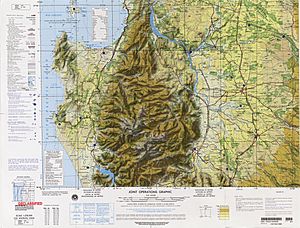Carampangue River facts for kids
Lua error in Module:Coordinates at line 614: attempt to index field 'wikibase' (a nil value).
The Carampangue River is a small but important river located in the Arauco Province of the Bío Bío Region in Chile. It flows through a beautiful valley and has played a role in the history of the area.
Contents
Where Does the River Start and End?
The Carampangue River begins its journey in the Nahuelbuta Range. Its main source is found in the hill of La Piedra, which is south of the Heights of Purgatorio. This area is southwest of the town of Santa Juana.
From its source, the river flows towards the northwest. It travels a good distance before finally emptying into the Bay of Arauco. This bay is located north of the town of Arauco, Chile.
What Feeds the River?
In its upper part, the Carampangue River gets water from many small streams. These streams flow down from the forests of the Nahuelbuta Range. They join the main river, especially in its lower section.
The river then flows through a wide and fertile valley. This valley is very open and has rich soil. The main smaller rivers that join the Carampangue are called the Conumo and Los Patos. These are known as its main tributaries.
Can Boats Use the River?
Yes, the lowest part of the Carampangue River is wide enough for small boats. About 12 to 14 kilometers (around 7 to 9 miles) of the river can be used for navigation. This means small vessels can travel along this section.
What Does the Name "Carampangue" Mean?
The name of the river has an interesting history. Originally, the upper part of the river had a different name in Mapudungun, the language of the Mapuche people. It was called Raghleuvu, which means "clay river."
The lower part of the river already had its current name, Carampangue. Over time, this name became used for the entire river. The word "Carampangue" is also from Mapudungun. It combines two words: caran, which means "to form a town," and pangui, which means "the lion." So, the name could mean something like "the lion's town" or "where the lion forms a town."
Historical Importance of the River
The Carampangue River valley was an important place in history. The Spanish explorer Pedro de Valdivia built a fort here. This fort was first known as San Felipe de Rauco, or sometimes Old Arauco. The town of Arauco was also built on the north shore of the river. This shows how important the river was for settlements and defense in the past.
See also
 In Spanish: Río Carampangue para niños
In Spanish: Río Carampangue para niños


